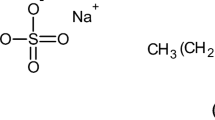Abstract
The fluorescence resonance energy transfer (FRET) from tyrosine to pyridoxine hydrochloride in different surfactant solutions and in deionized water has been investigated by using a fluorescence spectroscopic technique. The Stern–Volmer quenching constant, the distance between donor (tyrosine) and acceptor (pyridoxine hydrochloride), and the energy transfer efficiency were obtained using the Stern–Volmer relation and Forster’s theory of nonradiative energy transfer. The data obtained from the measurement reveals that the FRET occurs more effectively in aqueous SDS micellar solution than in CTAB or linear alcohol ethoxylate micellar systems and deionized water. Moreover, the binding constant, number of binding sites, and thermodynamic parameters ∆G, ∆H, ∆S were obtained by studying the tyrosine-pyridoxine hydrochloride interactions at three different temperatures. The decrease in binding constant with temperature reflects the existence of weak interaction between tyrosine and pyridoxine hydrochloride at high temperature. The analysis confirms that van der Waals forces and hydrogen bonding are involved in the interaction.







Similar content being viewed by others
Notes
As definite stoichiometry is maintained between donor and acceptor, an isoemissive point similar to isosbestic point in absorption is observed. So an isoemissive point is a specific wavelength at which total emission of sample does note changes during chemical reaction.
References
Seidel C, Orth A, Greulich K-O (1993) Electronic effects on the fluorescence of tyrosine in small peptides. Photochem Photobiol 58:178–184
Pal H, Palit DK, Mukherjee T, Mittal P (1990) Some aspects of steady state and time-resolved fluorescence of tyrosine and related compounds. J Photochem Photobiol A Chem 52:391–409. doi:10.1016/1010-6030(90)85018-R
Wiczk W, Rzeska A, Lukomska J, Stachowiak K, Karolczak J, Malicka J, Lankiewicz L (2001) Mechanism of fluorescence quenching of tyrosine derivatives by amide group. Chem Phys Lett 341:99–106. doi:10.1016/S0009-2614(01)00470-5
Lukomska J, Rzeska A, Malicka J, Wiczk W (2001) Influence of a substituent on amide nitrogen atom on fluorescence efficiency quenching of Tyr(Me) by amide group. J Photochem Photobiol A Chem 143:135–139. doi:10.1016/S1010-6030(01)00521-4
Gauduchon P, Whal P (1978) Pulse fluorimetry of tyrosyl peptides. Biophys Chem 8:87–104
Rehms AA, Callis PR (1993) Two-photon fluorescence excitation spectra of aromatic amino acids. Chem Phys Lett 208:276–282. doi:10.1016/0009-2614(93)89075-S
Beechem JM, Brand L (1985) Time-resolved fluorescence of proteins. Ann Rev Biochem 54:43–71
Pearce KN (1975) A fluorescence study of the temperature dependent polymerization of bovine beta casein A1. Eur J Biochem 58:23–29
Cuomo F, Ceglie A, Lopez F (2011) Temperature dependence of calcium and magnesium induced caseinate precipitation in H2O and D2O. Food Chem 126:8–14. doi:10.1016/j.foodchem.2010.10.021
Capek I (2002) Fate of excited probes in micellar system. Adv Colloid Interf Sci 97:91–149. doi:10.1016/S0001-8686(01)00049-5
Gehlen MH, DeSchryer FC (1993) Time-resolved fluorescence quenching in micellar assemblies. Chem Rev 93:199–221. doi:10.1021/cr00017a010
Hu Y-J, Liu Y, Pi ZB, Qu S-H (2005) Interaction of cromolyn sodium with human serum albumin: a fluorescence quenching study. Bioorg Med Chem 13:6609–6614. doi:10.1016/j.bmc.2005.07.039
Ghosh SK, Khatua PK, Ghosh JK, Bhattacharya SC (2004) Partitioning of quencher ions in the micellar microenvironment of polyoxyethylene nonyl phenol. Spectrochim Acta Part A 61:395–401. doi:10.1016/j.saa.2004.03.043
Lakowicz J R (2006) Principles of Fluorescence Spectroscopy, 3rd edn. Plenum Press, New York, pp 11, 13, 443–446
De S, Girigoswami A (2004) Fluorescence resonance energy transfer—a spectroscopic probe for organized surfactant media. J Colloid Inter Sci 271:485–495. doi:10.1016/j.jcis.2003.10.021
Aydin BM, Acar M, Arik M, Onganer Y (2009) The fluorescence resonance energy transfer between dye compounds in micellar media. Dyes Pigm 81:156–160. doi:10.1016/j.dyepig.2008.10.002
Kozyra KA, Heldt JR, Diehl HA, Heldt J (2002) Electronic energy transfer efficiency of mixed solutions of the donor–acceptor pairs: coumarin derivatives-acridine orange. J Photochem Photobiol A Chem 152:199–205. doi:10.1016/S1010-6030(02)00230-7
De S, Girigoswami A, Mandal AK (2003) Energy transfer—a tool for probing micellar media. Spectrochim Acta Part A 59:2487–2496. doi:10.1016/S1386-1425(03)00043-X
Cuomo F, Palazzo G, Ceglie A, Lopez F (2009) Quenching efficiency of pyrene fluorescence by nucleotide monophosphates in cationic micelles. J Photochem Photobiol A Chem 202:21–27. doi:10.1016/j.jphotochem.2008.10.028
Lopez F, Cuomo F, Ceglie A, Ambrosone L, Palazzo G (2008) Quenching and dequenching of pyrene fluorescence by nucleotide monophosphates in cationic micelles. J Phys Chem B 112:7338–7344. doi:10.1021/jp8003344
Mote US, Bhattar SL, Patil SR, Kolekar GB (2009) Interaction of fluorescein with felodipine: a spectrofluorometric and thermodynamic study. J Sol Chem 38:619–628. doi:10.1007/s10953-009-9397-0
Weiss S (1999) Fluorescence spectroscopy of single biomolecules. Science 283:1676–1683. doi:10.1126/science.283.5408.1676
Valuer B (2001) Molecular fluorescence: principles and applications. Wiley Press, New York, p 250
Chatterjee S, Nandi S, Bhattacharya SC (2005) Fluorescence resonance energy transfer from Fluorescein to Safranine T in solutions and in micellar medium. J Photochem Photobiol A Chem 173:221–227. doi:10.1016/j.jphotochem.2005.02.006
More VR, Mote US, Patil SR, Kolekar GB (2009) Spectroscopic studies on the interaction between norfloxacin and p-amino benzoic acid: analytical application on determination of norfloxacin. Spectrochim Acta Part A 74:771–775. doi:10.1016/j.saa.2009.08.016
Ross PD, Subramanian S (1981) Thermodynamics of protein association reactions: forces contributing to stability. Biochemistry 20:3096–3102. doi:10.1021/bi00514a017
Acknowledgments
GBK and USM thank UGC [Project F.No.32-263/2006 (SR)] for the project and fellowship respectively.
Author information
Authors and Affiliations
Corresponding author
About this article
Cite this article
Mote, U.S., Anbhule, P.V. & Kolekar, G.B. Surfactant and Temperature Effects in Tyrosine/Pyridoxine Hydrochloride Systems. J Surfact Deterg 19, 553–558 (2016). https://doi.org/10.1007/s11743-016-1807-x
Received:
Accepted:
Published:
Issue Date:
DOI: https://doi.org/10.1007/s11743-016-1807-x




